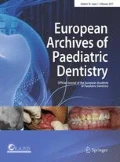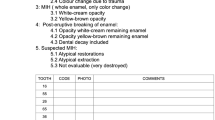Abstract
Aim: According to our earlier study, molar-incisor hypomineralisation (MIH) was associated with the exposure of a child via mother’s milk to polychlorinated dibenzo-p-dioxins/dibenzofurans (PCDD/Fs) in a group of Finnish children born in 1987. Since the levels of PCDD/Fs and PCBs in mother’s milk/placenta have remarkably decreased, it was important to find out if an association still exists. Methods: The study group was composed of 167 mothers and their children. Placental samples from the mothers were collected in maternity hospitals in Helsinki and Oulu in 1995–1999 and concentrations of the 17 most toxic PCDD/PCDF and 36 PCB congeners were measured. After 7–10 years the children were examined for MIH and the mothers were interviewed on the duration of breast-feeding. Results: MIH was found in 24 children (14.4%). The duration of breast-feeding ranged from 0 to 30 months (mean=7.2±4.7). WHOPCDD/F TEQ ranged from 2.5 to 39.1 pg/g fat (mean=13.7±6.8) and WHO PCB TEQ from 0.7 to 9.8 pg/g fat (mean=2.7±1.4). The mean sum of PCDD/Fs was 196±105 pg/g fat and that of PCBs was 57.2±28.1ng/g fat. The total exposure to PCDD/Fs, which was calculated from the placental concentration (used as a proxy for the milk concentration) and duration of breastfeeding, was not associated with the occurrence or severity of MIH. Neither was the total exposure to PCBs associated with the occurrence or severity of MIH. Conclusion: At prevailing levels, exposure of a child via placenta/mother’s milk to PCDD/Fs and PCBs is not associated with MIH.
Similar content being viewed by others
References
Alaluusua S, Calderara P, Gerthoux PM, et al. Developmental dental aberrations after the dioxin accident in Seveso. Environ Health Perspect 2004:112:1313–1318.
Alaluusua S, Lukinmaa P-L. Developmental dental toxicity of dioxin and related compounds — a review. Int Dent J 2006;56:323–331.
Alaluusua S, Lukinmaa P-L, Torppa J, Tuomisto J, Vartiainen T. Developing teeth as biomarker of dioxin exposure. Lancet 1999:353:206.
Alaluusua S, Lukinmaa P-L, Vartiainen T, et al. Polychlorinated dibenzo-paradioxins and dibenzofurans via mother’s milk may cause developmental defects in the child’s teeth. Environ Toxicol Pharmacol 1996;1:193–197.
Gao Y, Sahlberg C, Alaluusua S, et al. Lactational exposure of rats to 2,3,7,8-tetrachlorodibenzo-p-dioxin impairs tooth biomineralisation. J Dent Res 2004;83:139–144.
Hong L, Levy SM, Warren JJ, et al. Association of amoxicillin use during early childhood with developmental tooth enamel defects. Arch Pediatr Adolesc Med 2005;139:943–948.
Hurst CH, DeVito MJ, Setzer RW. Acute administration of 2,3,7,8-tetrachlorodibenzo-p-dioxin (TCDD) in pregnant Long Evans rats: association of measured tissue concentrations with developmental effects. Toxicol Sci 2000;53:411–420.
Jan J, Sovcikova E, Ko an, Wsolova L, Trnovec T. Developmental dental defects in children exposed to PCBs in eastern Slovakia. Chemosphere 2007;67:S350–S354.
Kattainen H, Tuukkanen J, Simanainen U, et al. In utero/lactational 2,3,7,8-tetrachlorodibenzo-p-dioxin exposure impairs molar tooth development in rats. Toxicol Appl Pharmacol 2001;174:216–224.
Kiviranta H, Ovaskainen ML, Vartiainen T. Market basket study on dietary intake of OCDD/Fs, PCBs and PBDEs in Finland. Environ Int 2004;30:923–932.
Kiviranta H. Exposure and human PCDD/F and PCB body burden in Finland. Thesis, Publications of the National Public Health Institute, A14/2005; 191.http://www.ktl.fi/attachments/suomi/julkaisut/julkaisusarja_a/2005/2005a14.pdf
Kiviranta H, Tuomisto JT, Tuomisto J, Tukiainen E, Vartiainen T. Polychlorinated dibenzo-p-dioxins, dibenzofurans, and biphenyls in the general population in Finland. Chemosphere 2005:60:854–869.
Klaukka T, Helin-Salmivaara A, Huupponen R, Idänpään-Heikkilä J. Consumption of bacterium medicines in the downturn. Suomen Lääkärilehti 2006;61:27–31.
Leeuwen FXR van, Malisch R. Results of the third round of the WHO-coordinated exposure study on the levels of PCBs, PCDDs and PCDFs in human milk. Organohalogen Compounds 2002:56;311–316.
Lukinmaa P-L, Sahlberg C, Leppäniemi A, Partanen A-M, Alaluusua S. Arrest of rat molar tooth development by lactational exposure to 2,3,7,8-tetrachlorodibenzo-p-dioxin. Toxicol Appl Pharmacol 2001;173:38–47.
Main KM, Kiviranta H, Virtanen HE, et al. Flame retardants in placenta and breast milk and cryptorchidism in newborn boys. Environmental Health Perspectives 2007;115(10): 1519–1526.
Partanen A-M, Kiukkonen A, Alaluusua S, et al. Developmental toxicity of dioxin to mouse embryonic teeth in vitro: arrest of tooth morphogenesis involves stimulation of apoptotic program in the dental epithelium. Toxicol Appl Pharmacol 2004;194:24–33.
U.S.A Environmental Protection Agency. In: http://www.epa.gov/ncea/pdfs/dioxin/dioxreass.htm.
Van den Berg M, Birnbaum L, Bosveld ATC, et al. Toxic equivalency factors (TEFs) for PCBs, PCDDs, PCDFs for humans and wildlife. Environ Health Perspect 1998;106:775–792.
Vartiainen T, Saarikoski S, Jaakkola JJ, Tuomisto J. PCDD, PCDF, and PCB concentrations in human milk from two areas in Finland. Chemosphere 1997;34:2571–2583.
Wang SL, Chen TT, Hsu JF, et al. Neonatal and childhood teeth in relation to perinatal exposure to polychlorinated biphenyls and dibenzofurans: observations of the Yucheng children in Taiwan. Environ Res 2003;93:131–137.
Weerheijm KL, Jälevik B, Alaluusua S. Molar-Incisor Hypomineralisation (MIH). Caries Res 2001;35:390–391.
Author information
Authors and Affiliations
Corresponding author
Rights and permissions
About this article
Cite this article
Laisi, S., Kiviranta, H., Lukinmaa, P.L. et al. Molar-Incisor-Hypomineralisation and Dioxins: New Findings. Eur Arch Paediatr Dent 9, 224–227 (2008). https://doi.org/10.1007/BF03262639
Published:
Issue Date:
DOI: https://doi.org/10.1007/BF03262639




